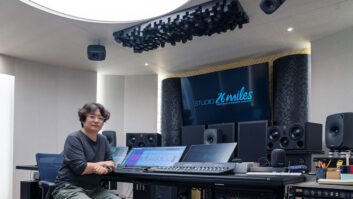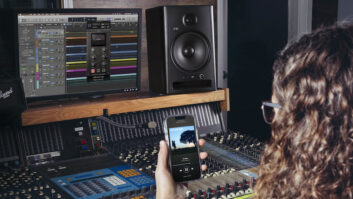Manifold features a 4,000-square-foot main studio, which is home to unnamed shapes, most evident in the cloud panels overhead.In a lovely rural locale outside Pittsboro, North Carolina—15 miles south of Chapel Hill—is arguably our industry’s most ambitious new music production facility, Manifold Recording. A flight away from bustling entertainment industry hubs, this high-end, carbon-neutral facility’s architecture is as uniquely aesthetically striking as it is far beyond functional. It primarily was designed and built to inspire, to capture the art of live musical performance. At a glance, it is equal measures of art and mathematics, emulating its unspoiled, rural surrounding in an organic way, making it visibly similar, both inside and out, to the prairie school architecture of Frank Lloyd Wright.

The facility offers a 4,000-squarefoot main studio with the loggia (front porch), featuring west and north patios; the 1,700-square-foot studio annex, which includes Manifold’s large lounge; and, just up the hill, the Windsong Bed, Breakfast and Retreat Center, perfect for a half-dozen guests working at Manifold. The main studio has a 64-channel API Vision analog console, while the annex offers its “yang”—a digital Harrison Trion mixer and DAW control surface.
The Manifold “dream team” includes prime visionary Michael Tiemann; his wife and business partner, producer Lisa Tiemann; studio designer Wes Lachot; and chief engineer Ian Schreier.
Michael Tiemann says he thought it reasonable to refer to Manifold “as a Nashville-style room,” when discussing the performer-friendly concept and design. “Nashville is about great musicians playing together. Nashville is about capturing live sound. The way we made all of this visible—the way the booths, the main room and the control room connect visually—we open those double doors, then it connects acoustically. It all supports the idea of having every musician able to completely access every other musician according to the needs of the recording.”
You might expect to find this kind of premium music production facility in the heart of Music City (or any major production center), but perhaps not a locale traditionally home to slower-paced, peaceful rural life. This duality, it seems, is a large part of Manifold’s magic. “You can get the architectural tour and have everything pointed out to you, which is something we like to do,” Lisa Tiemann points out. “But even if it’s not explained to you, it looks right. It feels right. You get the harmony whether or not you are conscious of the math.”
Manifold’s essence is an interesting blend of ideas, theories and serendipity, which can be primarily attributed to the collaboration of Michael Tiemann and Lachot. Tiemann is a lifelong musician and a co-founder of Cygnus Solutions, the free/open source software pioneers eventually acquired by Red Hat, based in Raleigh (one corner of the world-renowned Research Triangle Park); he clearly has a mind for both music and math. For the serendipitous part, Lachot is a longtime resident of Chapel Hill (another corner of the Triangle).
“Wes builds studios all over the country, all over the world,” Lisa Tiemann says. “Michael would’ve picked a designer from anywhere in the world, which he did; he literally was looking for the best designer, and he lives in Chapel Hill.”
Their geographical closeness was a boon for Manifold. “I would not have wanted to pull this job off in California,” reasons Lachot. “Without moving, it would have been impossible for this particular job. Michael’s vision for it, and our shared visions of it, were very close, and especially in our meticulousness to the vision. It’s really difficult to get this level of detail without this kind of vision.”
At Manifold, everywhere you look are physical examples of that meticulous vision: its many pieces, and their composition, fit and finish. “You won’t see any trim wood hiding the meeting of one material with another material,” reveals Lachot as he points out Manifold’s details, populated with many RPG Diffusor Systems’ products such as Topperfo, Topakustik, and the locally manufactured, RPG-licensed, concrete diffusor blocks. “It’s a QRD (quadratic residue) diffusion thing, the same math as behind the other diffusors. There are two different kinds of block that create the QRD pattern, two different kinds of Helmholtz resonators that create a basstrapping effect. These columns that hold up the building are also acting as bass traps.”
Manifold is even home to unnamed shapes, most evident in the cloud over the main studio’s music room. “Based on geodesic principle— the Golden Mean, or the Golden Ratio—it is a mathematical principle inherent in nature,” explains Lachot. “Half of the cloud panels are RPG diffusor panels and the other half are absorbers. It’s a combination of absorption, diffusion, and reflection going on, and not too much of any one of them.” It is attractive, yet with physical purpose. “The cloud hides the giant air return in the middle—one that is 25-square-feet wide—so the air is moving very slowly,” Michael Tiemann relates. “The bottom line is that this shape does not yet have a name; algebraic topologists are currently working on the nomenclature that would give it a name.”
Considering his proven background in developing digital solutions, “getting to the API Vision was not an easy path,” Tiemann admits. “My history is very related to high-tech Moore’s Law digital technologies. I believed that digital technology was ultimately going to win the technology warfare against analog; it was just a matter of time. I’m not alone in making that prediction; George Massenburg has famously said that for years. However, as we were building this organic, holistic facility, it became very obvious that if ever there was a facility that needed the heart and soul of analog at the control room, this was it, and the API Vision was the ultimate heart and soul for it.”
Investigative trips to Nashville brought the Manifold team to “the consensus that we really already knew” regarding the API Vision, Tiemann says. Yet, in the process, it also brought them to the doorstep of Harrison Consoles. “What I did not know was that their digital strategy was based on open-source software: their OS is Linux and their DAW is Ardour. I really wanted a Harrison console from that day, but you can’t put two consoles in one room.”
Thus, the annex, featuring the Harrison Trion, was born. “There are a couple of different reasons for it,” Tiemann continues. “Our digital audio infrastructure is completely independent of brand-specific software. We are not beholden to any brand or flavor. The Harrison operates on MADI, so we have 32 channels going each way at 96 kHz on one RG-6 wire. So when this connects to the MADI router—basically a switch made by Harrison—we can direct those MADI signals any way we want. It gives us the flexibility to being open to whatever someone wants to bring in. We obviously support Pro Tools, and there’s a lot of momentum behind the platform. But the point is, if someone prefers to work natively in something else— Logic, Nuendo, Cubase, or whatever— we can load the software on our computer, and away we go.”
Manifold Recording
manifoldrecording.com
Strother Bullins is the editor for PSN’s sister publication, Pro Audio Review.







